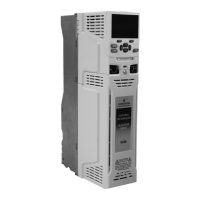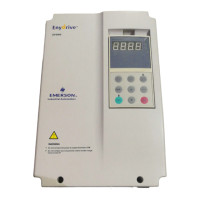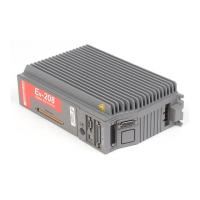12. As before, the drive enable must be removed and re-applied before the drive can be restarted after the trip has been reset. Care should be taken
values.
1. The autotune relies on the motor being stationary when the test is initiated to give accurate results.
2. Parameters associated with the motor and feedback position feedback phase angle are updated following successful completion of the autotune
test.
3. If the autotune test is not completed successfully parameters will retain their original values resulting in incorrect operation if the drive is enabled.
4. When each stage of the autotune test is complete the results are written to the appropriate parameters, and these parameters are saved in the
5. If Parameter Cloning (N01) is set to Auto (3) or Boot (4) the parameters are also written to a NV Media Card installed in the drive.
Select rotating autotune
A26 B11(Motor Autotune ) = 2 (Autotune test 2)
Rotating test for control parameters
Output motor contactor control
Output motor contactors must be
manually closed for the entire autotune
Autotune
active
Motor and encoder (RFC-A, RFC-S) parameters
Motor and encoder details must be
setup in the drive parameters
Motor brake control
Motor brake control manually activated
opening brake for the entire autotune
Control inputs for the autotune
Safe Torque Off (STO), Drive enable via output motor contactors
Fast disable input (if used) selected
Run (direction input) selected
Zero speed selected
Display
Inhibit
Drive display
Run AutoT une
alternates
between
and
Display
Inhibit
AUTOTUNE COMPLETED
No
Yes
No
Yes
Yes
No Drive trip
Ensure drive is disabled and all trips are
reset (refer to diagnostics for trip details).
Ensure correct sequence for autotune
Motor brake opened
Refer to diagnostics for trip details
Control inputs active
Motor contactors closed
Autotune completed and parameters
updated
Press on KI-Elv Keypad RTC
for drive status
Refer to diagnostics for any trips which
may occur during autotune.
Brake must be applied and motor contactors
opened during drive trip
The motor will rotate by 2 electrical rev’s
(i.e. up to 2 mechanical rev’s) in the
selected direction
START
ROTATING AUTOTUNE
For rotating autotune the elevator car should
be de-roped, or alternatively the system must
have no load and be in balanced condition
The motor is accelerated with
the selected ramps to 2/3 rated
frequency and is maintained at
that level for up to 40 s (RFC-A)
4 s (Open loop) in the selected
direction
RFC-A
Open loop
RFC-S
Return drive to normal operation
Apply motor brake
Remove manual control of output motor contactors
Remove Safe Torque Off (STO), Drive enable
Remove Fast disable input (if used)
Remove Run (direction input)
Remove speed selection

